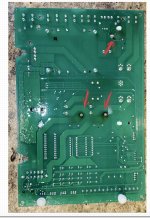High salt level following adding salt to quickly is the likely cause of getting 0000 amp readings with no error message/light. But oddly, the 0000 amp reading kicks in after about 30 minutes of resetting it via the Diagnostic menu. Resetting it gets me all normal readings …then its back to the 0000 amps. Ruled out the T-15 and flow switch (have 2 working cells to troubleshoot). Its almost like the cell goes into a time out, as would be the case when the cell on percentage is set to, say, 20% (issue occurs at 100% ..or any other setting).
Turned the control board over and found burn spots on one K2 relay pin pad and the same pin pad of the K3 relay. Also, seemed like there is a little burn mark on one of the pin pads of the K1 relay, which evidently is not uncommon when subjected to a high voltage spike. I did a resolder of all three pin pads but the issue still persists. Have replacements on the way for the K2 and K3 so will replace those to see if that works. Might do the same for the K1 relay.
My question is whether or not the issue lies with the component that determines when the cell goes into an inactive state (as when a low percentage setting of the chlorinator requires this to occur). My fear is that the relays to be replaced are not the cause of this problem, even though hi salt levels will induce high current and fry components …or in a related sense, cause solder on the pin to dislodge and lack contact of relays, etc.
Oh…and these replacement relays are now discontinued so replacements are going to be used (not willing to risk “new” relays that come on a boat from a couple of non rated sellers in China). Some sell what are claimed to be compatible relays but dubious about going that route.
Hoping my board is not one of those where the problem fails to be resolved with the more commonplace repair methods as seen on several youtube vids …and on this forum (e.g., resoldering a pin lossened by high heat caused by a voltage spike when a lot of salt gets sent through the salt cell).
Turned the control board over and found burn spots on one K2 relay pin pad and the same pin pad of the K3 relay. Also, seemed like there is a little burn mark on one of the pin pads of the K1 relay, which evidently is not uncommon when subjected to a high voltage spike. I did a resolder of all three pin pads but the issue still persists. Have replacements on the way for the K2 and K3 so will replace those to see if that works. Might do the same for the K1 relay.
My question is whether or not the issue lies with the component that determines when the cell goes into an inactive state (as when a low percentage setting of the chlorinator requires this to occur). My fear is that the relays to be replaced are not the cause of this problem, even though hi salt levels will induce high current and fry components …or in a related sense, cause solder on the pin to dislodge and lack contact of relays, etc.
Oh…and these replacement relays are now discontinued so replacements are going to be used (not willing to risk “new” relays that come on a boat from a couple of non rated sellers in China). Some sell what are claimed to be compatible relays but dubious about going that route.
Hoping my board is not one of those where the problem fails to be resolved with the more commonplace repair methods as seen on several youtube vids …and on this forum (e.g., resoldering a pin lossened by high heat caused by a voltage spike when a lot of salt gets sent through the salt cell).

Attachments
Last edited:





